Try this little-known fact on for size: Approximately one-quarter of New England — a region first settled four centuries ago — is almost entirely undeveloped. Never mind images of East Coast overcrowding and sprawl; travel far enough north and east and you can drive for hours and see no Main Streets, no local fire departments, no permanent dwellings, no Wal-Marts. Just forests and lakes and beaver and moose.
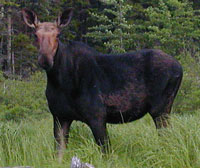
Here’s moose. Where’s squirrel?
Photo: Wayne Curtis.
About half of Maine (itself nearly the size of the other New England states combined) is composed of what are called the “unorganized territories” — privately owned land with no local government and few residents. The unorganized territories consist mostly of industrial forestland laced by dirt roads that are traversed by logging trucks piled as high as three-story buildings.
The region keeps a pretty low profile. But in recent months this unpopulated corner of the country has emerged as a sort of petri dish for an unprecedented experiment in land conservation. The experiment involves conservation easements. Really, really big conservation easements.
You’re probably somewhat familiar with easements — they’re a decades-old tool used to protect privately owned land. Citizens concerned about the changing character of their communities typically band together as a local land trust, then purchase (or request a donation of) development rights on a piece of land, often property with a beloved view or a historic farm. The land doesn’t change hands, but development restrictions remain an irrevocable part of the deed, binding on all subsequent owners.
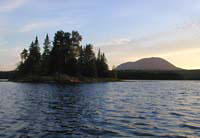
Land surrounding Big Spencer
Mountain could be protected
with a mega-easement.
Photo: Wayne Curtis.
This new generation of Maine North Woods easements — dubbed mega-easements by some — are on a scale large enough to be classified as almost wholly different species. How mega is mega? The Pingree family, which owns nearly 1 million acres of Maine timberlands, has offered to sell development rights on 757,000 acres of land. And Wagner Timberlands is currently negotiating to sell development rights on 656,000 acres of timberland that it manages for two other landowners.
Let’s put these numbers in perspective. In 1998 the Land Trust Alliance identified 1.385 million acres nationwide protected by conservation easements held by the nearly 1,000 local, regional, and state land trusts that responded to the survey (this out of 1,213). These two Maine deals, if completed, will more than double that amount. (Another 888,000 acres is protected under conservation easements overseen by the three most prominent national organizations, including The Nature Conservancy; no figure is available for easements held by the federal government.)
In Maine, it’s as if easements have gone overnight from bit role to center-stage star. And with the starring role comes a key question: Do large-scale easements really make sense?
New Boss — Same as the Old Boss?
About 11.5 million acres of Maine is commercial timberland interspersed with fast-flowing streams and pristine lakes. Traditionally, most of these lands were owned by paper and lumber companies, and when they sold their land — which wasn’t often — it was almost always to like-minded companies more interested in standing timber than house lots. What’s more, landowners have traditionally allowed public access for hunting, fishing, and canoeing, so much of the state’s huge private forest has served as de facto park land.
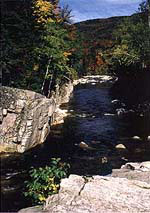
Maine stream.
Photo: USFWS.
But these long-established patterns of land ownership are rapidly changing. Since October 1998, an astonishing 22 percent of the state’s land has changed hands. Many Maine-based paper and lumber companies have exited. Taking their place are international corporations, pension funds, family trusts, and even the occasional billionaire (such as cable TV mogul John Malone); these new owners have snapped up thousands of acres of timberland.
A change in ownership always brings uncertainty, and it’s as yet unclear to what extent new owners are interested in trees and to what extent in the land’s potential value as second home lots. Fueling conservationists’ concerns about the latter possibility is the fact that one of the newcomers is Seattle-based Plum Creek Co., a timber management firm that has actively subdivided and sold off vacation home lots in other states, including Montana.
A public consensus seems to be emerging that the Maine North Woods, the largest tract of forestland in the East, should remain undeveloped and unbroken. But how? Some environmental groups have been pushing for a new 3.2 million acre national park — but the viability of this plan is questionable. The national park system may be much beloved nationwide, but in much of rural Maine — home to a notably cranky group of land rights advocates — the park system is associated with black helicopters and jackbooted government agents. (In one memorable episode two years ago, a land-rights crusader held a press conference in which he hacked a watermelon in half to make the point that environmentalists were green on the outside and red on the inside.) Politically, a new national park faces extremely longs odds, at least in the short term — especially given the outcome of the presidential election.
Appeasement Through Easements
Enter conservation easements. According to Alan Hutchinson, executive director of the Forest Society of Maine, easements are something of a hybrid, a tool that allows the marriage of “public values with private lands.”
The Pingree family, which has owned and managed Maine forestland for 159 years, has offered to sell development rights on 757,000 acres of its land for $28 million, or $37.10 per acre. The family will get cash up front to help pay inheritance taxes, and it will retain ownership of the land on which it can continue logging. The public will get a guarantee that its lakes and backwoods will never be besmirched by blue tarps and A-frames, and that vast tracts of timberland will remain home to moose and marten and veeries. The deadline for fundraising was December 31, 2000, and Keith Ross of the New England Forestry Foundation says money is still trickling in. He expects the deal will close in mid-March.
In the case of the 656,000-acre Wagner Timberlands easement, the public will pay more and get more. Although the exact terms are still being hammered out, the easement will likely include guarantees of public recreational access and may incorporate reduced timbering rights on more sensitive portions of the holdings. The price for the easement is estimated to be upwards of $50 per acre.
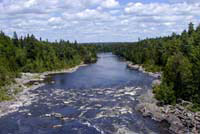
The West Branch of the Penobscot River.
Photo: Wayne Curtis.
The first phase focuses on 67,000 acres surrounding the headwaters of the West Branch of the Penobscot River (which Henry David Thoreau paddled in the mid-19th century). The terms have been already agreed upon; the two sides are still wrangling over what the final price tag will be. The first phase is expected to be completed by the end of February. The deal also includes a sale to the state of about 10 miles of shorefront on Moosehead Lake (the state’s largest lake) and 4,000 acres surrounding Big Spencer Mountain, one of the region’s most
prominent peaks. The second phase, encompassing the remaining 589,000 acres, will probably include a similar mix of easements and acquisitions.
The public gets irrevocable guarantees that huge tracts of open space will not be developed. The timber companies get to retain and manage their lands. A classic win-win. So what’s not to like about easements?
“I’m not saying that they don’t have a value,” says Jym St. Pierre, Maine director of Restore: The North Woods, a group advocating a new national park. “They can be a useful, long-term step in preserving real wilderness.”
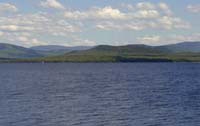
Moosehead Lake.
Photo: Wayne Curtis.
But St. Pierre has worries. He’s concerned that the mega-easements will do little to address some of the central problems facing the North Woods. “What people are clamoring for is wilderness, and that’s not what these easements are protecting,” he says, noting that timber companies have failed to manage their lands sustainably and that monocultural, plantation-style forests are fast eroding the region’s biodiversity. “These aren’t ‘forever wild’ easements,” he says. “Some people call them ‘forever logging’ easements.”
St. Pierre adds that while it’s admirable that much lakefront land is being protected, millions of dollars are also being diverted to protect scrappy backlands that would never have been in high demand as second home lots. Those millions could have been used instead to purchase lands more deserving of broader protection, he says, and to create more wilderness.
Yet the biggest concern may be one of perception — the public may hear about these deals and breathe a sigh of relief that the forest has been preserved in perpetuity. “I don’t want people to read about these big easements and think we’ve finished the job,” says St. Pierre. “We haven’t. We’ve only started the job.”


